Ostrava mills
Mills in Moravská Ostrava and Přívoz
The water mills were very likely to start to appear in Moravian Ostrava simultaneously
with the establishment of the city in the thirteenth century but the oldest document
about them was not earlier than in 1396. It is some kind of a proof of the upper
and middle mill possession which were both the property of Ostrava´s reeve. The
lower mill which later got the ,,surname" Valchovni must have already existed this
time. Then followed the Field mill which was found during the influence of the bishop
of Olomouc, Stanislav Pavlovský. These four mills worked all centuries when they
were joined at the end of the last century by the ,,modern" mill for production
of hulled grain and groats.
Mills in land Ostrava
Horní ostravský mlýn
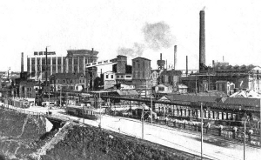
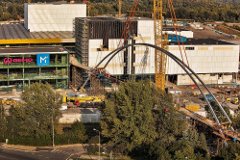
Karolina 1939, New Karolina 2012
Upper Ostrava´s mill used to be about 270 m north-east of today´s railway station
Ostrava-střed. The oldest information on it is from 1396. The last owner – from
December 19th 1894 the Vítkovice Mining and Metallurgical Plant continued in former
operation for several years but at the end of the century the mill and the sawmill
totally closed as the operation of the shaft and coking plant Karolina increased.
Bližní ostravský mlýn
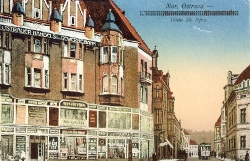
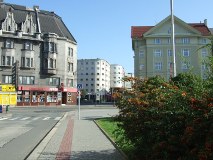
Year 1920, situation today
Ostrava´s nearby mill used to be in the place of the Imperial hotel newer wing in
28.října street. Also this mill in 1396 already existed. The last owner since 1892
was Josef Brauner. In 1898 the mill reportedly burned down.
Valchovní (dolní) mlýn
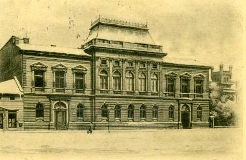
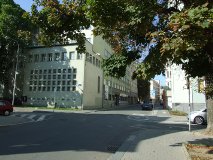
mill to the right of the theater - year 1900, situation today
Valchovní mill is reminded by the memorable board in Mlýnská street. The mill used
to be somewhere opposite the telecomunications building. Also this third mill already
existed at the end of the fourteenth century. Rudolf Kolovrat from Hrušov was the
last miller in the Vlachovní mill. In 1912 the mill burned down. The machine device
was sold to scrap and the building was used for other purposes for some time.
Polní mlýn
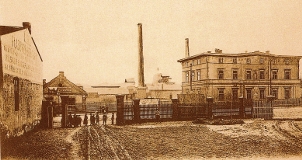

Reimann factory 1900, situation today
Field mill is mentioned in the oldest Ostrava´s register in 1625. The Field mill
used to be somewhere in today´s Petr Bezruč park, in Ostrčilova street. In August
2nd 1859 the whole complex burned down and in 1865 his owner Dingler built a new
paraffin and paraffin refinery factory. At the same time he built a new steam mill
and a bakery. In 1880 during a serious flood there was a fire in which this mill
burned down.
In 1888 on the burnt place company W. Reimann built a new paperboard factory. The
mill was not restored.
Mills in land Přívoz
The first news about the mills in Přívoz are from the beginning of the 17th century but everything indicates that both oldest mills – the Upper and the Lower one – existed already at the end of the 14th century when the colonization of Přívoz was finished.
Horní přívozský mlýn
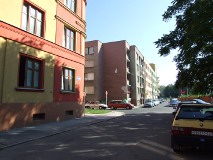
situation today
Upper mill in Přívoz used to be the biggest one from the three mills in Přívoz.
The oldest report about this mill is from 1614, the mill was situated behind Božena
Němcová park in the place where there are residential buildings today. After 47
years of possession, Josef Neuser, the last miller of the Upper mill sold this mill
including the agricultural homestead to Opava´s company Tlach and Keil - zinc rolling
mill in March 16 1853 for 11000,- PLN. Božena Němcová park is actually the first used
brownfield in big Ostrava. The former zinc company Tlach & Keil company was at the end
of the 19th century dissolved. The city bought the land in 1901. Opava´s company of
Skazik brothers that owned the first silesian forest school and a florist shop and
an artistic and trade garden centre worked out in 1903 a project of the park architectonic
development including the calculation of the woody plant quantity. The planting lasted
until 1907 after which the park was fenced and there were put two gates that were
locked at night. The park had twelve hectares but today there is just less than
one tenth of its former area.
Faldynovský mlýn
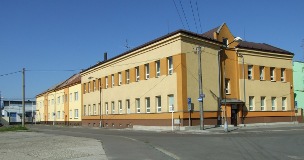
situation today
This smallest mill in Přívoz used to be in Valchařská gutter under Nakvarovský pond
in the place where Vlachařská gutter emptied into the Mill stream. As the main task
of the gutter was to supply the pond with water the first miller Jakub Faldyna got
the right just to the superfluous water from the Nakvarovského pond under which
dam he could build an one-wheel mill. It happened on the basis of agreement with
the city in February 16 1666. Faldynovský mill was in turns a mill and a draper´s
fulling mill, mostly both at the same time.
Even in 1880 the building was called a flour mill. Owners hired out this building
to private tenant farmers, one of the last farmers known in 1923 was Rudolf Blahuta.
In 1926 the City of Ostrava bought the mill and in the same year sold to the lessee
Rudolf Blahuta.
The shutdown of the mill is dated to 1926. Today there are no footprints left behind
it, only the street behind the railway track where the mill used to be with its name
„Na Valše“ reminds its existence.
Dolní Hechtrův mlýn
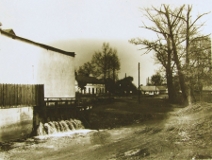
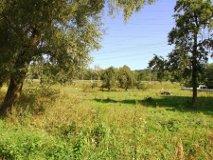
Mill Hechtr in 1900, situation today
Lower mill in Přívoz was built before 1616 and was situated on the joined watercourse
of the Mill stream and Valchařská gutter, at the mouth of Odra river. In 1916 the
company Ostrava´s mills, owner of the mill in Třebovice, gained this mill. This
very year 1917 the company invested to the device of the mill and changed the machines
for more effective and modern ones. In 1922 the City of Moravian Ostrava gained
this mill and immediately in 1923 sold the mill as the former mill to Mark Shoefer,
businessman with old iron.
Today there are no footprints left behind this mill Hechtrův mill (Lower one in Přívoz)
was in Vyravova street, today Na náhoně Land Registry Number was 22.
Other mills that were situated in Ostrava were outside the territory of Moravian
Ostrava and Přívoz. Also information on these mills are in the museum on individual
panels. It is the mills in Hrabová, Kunčice, Bartovice, Svinov, Poruba, Třebovice,
Stará Bělá, Proskovice, Polanka and Koblov.